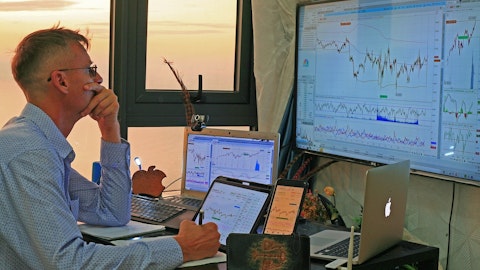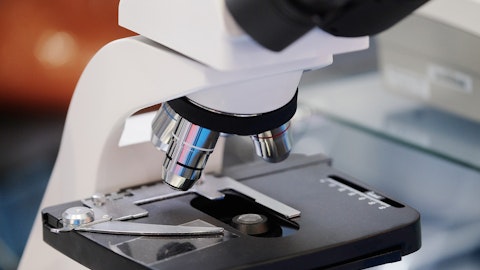Teledyne Technologies Incorporated (NYSE:TDY) Q2 2023 Earnings Call Transcript July 26, 2023
Teledyne Technologies Incorporated misses on earnings expectations. Reported EPS is $4.43 EPS, expectations were $4.64.
Operator: Ladies and gentlemen, good morning. Thank you for standing by today’s conference assembled [ph]. Welcome to the Teledyne Technologies Second Quarter Earnings Call. [Operator Instructions] At this time, it’s my pleasure to turn the conference over to our host, Jason VanWees. Please go ahead.
Jason VanWees: Thank you, Dom. This is Jason VanWees, Vice Chairman. I’d like to welcome everyone to Teledyne’s second quarter 2023 earnings release conference call. We released our earnings earlier this morning before the market opened. Joining me today are Teledyne’s Chairman, President and CEO, Robert Mehrabian; Senior Vice President and CFO, Sue Main; and Senior Vice President and General Counsel, Chief Compliance Officer and Secretary, Melanie Cibik. Also joining is Edwin Roks, Executive VP. After remarks by Robert and Sue, we will ask for your questions. Of course, though, before we get started, our attorneys have reminded me to tell you that all forward-looking statements made this morning are subject to various assumptions, risks and caveats as noted in our earnings release and our periodic SEC filings.
Actual results may differ materially. In order to avoid potential selective disclosures, this call is simultaneously being webcast and a replay, both via webcast and dial-in, will be available for approximately one month. Here is Robert.
Robert Mehrabian: Thank you, Jason and thank you for joining our earnings call. In the second quarter, we achieved all-time record quarterly sales, with overall sales increasing 5.1%. Furthermore, sales as well as GAAP and non-GAAP operating profit and operating margin increased year-over-year in every segment. For the total company, GAAP and non-GAAP operating margins increased 105 and 73 basis points, respectively. Excluding foreign currency headwind, which negatively impacted second quarter sales growth by approximately 40 basis points, growth in local currency would have been 5.5%. GAAP operating margin of 18% was a second quarter record and non-GAAP operating margin was 21.4%. Second quarter GAAP earnings per share were $3.87 and non-GAAP earnings of $4.67 were also second quarter records.
And finally, including continued debt repayment through July, which totaled about $620 million year-to-date, our consolidated leverage ratio declined to 2.1x. I’ll now comment a bit further on the performance of Teledyne flare and the announced cost reductions and the outlook for the balance of the year. In the 2 years, since we’ve owned FLIR, we’ve resolved the most significant legacy tax matters, exited the consent agreement with the Department of State, consolidated leadership in marketing and operations for the FLIR Defense portfolio and corrected some historical product quality issues. As part of this effort, we also took a much more focused view of the Defense business, aggressively pursuing those opportunities where we have truly differentiated technology.

Photo by Adam Nowakowski on Unsplash
I am pleased to report that the order book and backlog of FLIR, specialty FLIR Defense, significantly inflected during the second quarter. For reference, the commercial business across digital imaging, both DALSA to FLIR grew organically in the second quarter. While FLIR Defense sales declined year-over-year, nearly all of this was lower revenue in unmanned ground systems as we achieved the milestone of shipping our 1,000th man transportable robotic system increment to, to the U.S. Army. Overall, orders at all of FLIR were 1.18x sales and 1.5x sales at FLIR Defense. Large orders not only included the recently announced Black Hornet Nano UAV to the U.S. Military but also additional UAVs for customers in Europe as well as counter UAV systems and missile systems utilizing both FLIR imaging, radar and AI-based software systems.
Additionally, more surveillance imaging systems for the U.S. and foreign customers. Having stabilized the business, including achieving stronger backlog, it is not time to focus on execution and additional margin improvement. Thus, the charges announced this morning are for the further reduction in the FLIR operating footprint and related headcount. We are exciting the elimination of 3 lease sites, all of those activities will be relocated to other FLIR Defense facilities, most of which are locates. Today, we are reaffirming our prior 2023 full year sales and non-GAAP earnings outlook, including — excluding the $10 million to $12 million charges that — covered. Supply chain challenges have continued to improve and we were once again able to exceed our original second quarter sales and earnings outlook by pulling forward some revenue from the third quarter.
On revenue specifically, we continue to see total 2023 growth of approximately 5% or sales of approximately $5.73 billion, with the third quarter being roughly $1.4 billion. We continue to see non-GAAP earnings of $19.10 at the midpoint of our guidance, excluding the charges referenced above. I will now further comment on the performance of the 4 business segments. Second quarter sales, in our Digital Imaging segment, increased 2.3% with greater sales of X-ray products, commercial infrared imaging components and solutions and industrial scientific cameras partially offset by lower sales of unmanned ground systems for Defense applications. GAAP segment operating margin increased 51 basis points to 15.7% and adjusted for reduced the intangible asset amortization non-GAAP segment margin was 28 basis points higher at 21.5%.
Turning to our Instrumentation segment. Overall, second quarter sales increased 5.1% versus last year. Sales of Marine instruments increased a healthy 10.5% in the quarter, primarily due to ongoing recovery in offshore energy markets, also greater sales of autonomous underwater vehicles. Sales of electronic test and measurement systems, which include oscilloscopes, digitizers and protocol analyzers, collectively increased 4.9%. We encountered some softness in sales of analyzers for electronic storage and data center application but this was more than offset by [indiscernible] for wireless and video protocols as well as continued strong sales of oscilloscopes. Sales of environmental instruments were flat compared to last year with greater sales of air quality, process gas, safety analyzers offset by drug discovery and laboratory instruments.
Overall, instrumentation segment operating profit increased 10.6% in the second quarter, with GAAP operating margin increasing 123 basis points to 24.8% and 80 basis points on a non-GAAP basis, excluding reduced intangible asset amortization to 25.9%. In the Aerospace and Defense Electronics segment, second quarter sales increased 10.2%, driven by growth of both Defense Electronics and Commercial Aerospace products. GAAP and non-GAAP segment operating profit increased over 20% with margins approximately 250 basis points greater than last year. In the Engineering Systems segment, second quarter revenue increased 18.5% and operating profit increased 33.7%, representing 112 basis points increase in margin from last year. In conclusion, our short-term, more economically sensitive businesses remained resilient in the second quarter, collectively growing year-over-year, although comparisons for some do become more difficult in the second half.
In addition, our longer Cycle Medical, Aerospace, Defense and Marine businesses continued to perform very well. Quarterly operating margin in our Instrumentation segment was an all-time record. Operating margin in our Aerospace and Defense Electronics segment was the second quarter record and just slightly less than the fourth quarter of last year. And now through a combination of sales growth, operating leverage and the more aggressive cost actions mentioned earlier, I fully expect digital imaging margins to grow considerably over time. And now I’m going to turn the call over to Sue.
Sue Main: Thank you, Robert and good morning, everyone. I will first discuss some additional financials for the quarter not covered by Robert and then I will discuss our third quarter and full year 2023 outlook. In the second quarter, cash flow from operating activities was $190.5 million. Free cash flow, that is cash from operating activities less capital expenditures was $163.2 million in the second quarter of 2023 compared with $176.1 million in 2022. Capital expenditures were $27.3 million in the second quarter of 2023 compared with $20.8 million in 2022. Depreciation and amortization expense was $80 million for the second quarter of 2023 compared with $82.7 million. We ended the quarter with approximately $2.99 billion of net debt.
That is approximately $3.35 billion of debt less cash of $364.2 million. Stock-based compensation expense was $8.4 million in the second quarter of 2023 compared with $6.4 million in 2022. Turning to our outlook. Management currently believes that GAAP earnings per share in the third quarter of 2023 will be in the range of $3.76 to $3.90 per share, with non-GAAP earnings in the range of $4.70 to $4.80. And for the full year 2023, our GAAP earnings per share outlook is $15.60 to $15.88. And on a non-GAAP basis, we are maintaining our prior outlook of $19 to $19.20. Both the third quarter and full year non-GAAP outlook excludes estimated pretax charges for further FLIR integration costs, the 2023 full year estimated tax rate, excluding discrete items, is expected to be 22.3%.
I’ll now pass the call back to Robert.
Robert Mehrabian: Thank you very much, Sue. We would now like to take your questions. Operator, if you’re ready to proceed with the questions and answers, please go ahead.
See also 30 Best Excuses to Get Out of Work Provided By AI Chatbots and 26 Biggest Marijuana Companies in the World.
Q&A Session
Follow Teledyne Technologies Inc (NYSE:TDY)
Follow Teledyne Technologies Inc (NYSE:TDY)
Operator: [Operator Instructions] And our first question today will come from the line of Jim Ricchiuti.
Jim Ricchiuti: I wanted to talk a little bit, Robert, if I may, about digital imaging. If we exclude the acquisitions, it looks like your revenues were down year-on-year and sequentially. And some of this may be partly due to what you’re seeing at FLIR. But I wonder if you could just expand on what you’re seeing in digital imaging just because it’s a large category that covers a lot of ground?
Robert Mehrabian: Well, thank you. I think what you’re referring to is in the organic growth or decline year-over-year was a little over 1% decline — 1.5% to be exact. We see several things: First, there are government programs that we have in digital imaging, especially in FLIR, that declined year-over-year. On the other hand, as I mentioned, we had a very successful first half, especially second quarter, in getting orders for products both here and in Europe. So we feel that, that part of the business is stabilized. On the rest of digital imaging, if you look at health care, which is part of our business there, there’s been significant expansion in health care and medical. If you look at commercial aero, any parts of digital imaging that deal with, let’s say, satellite communication there has been expansion.
I think there is some headwind in the commercial part of digital imaging in the Far East but our exposure there is not that high. And we’re making that up with new products in — that includes some of our artificial intelligence capabilities. So we feel comfortable with our commercial aspect of our Digital Imaging. So in summary, I would say that — there is a little pressure on parts of our digital imaging in the Far East, especially China but this is offset by other products that we manufacture for Europe and the U.S. So I would say machine vision, which is what I’m referring to, is going to be relatively flat, maybe a little down year-over-year. But the other parts of Digital Imaging are going to be healthy. And we feel pretty good about that.
So all in all, it’s a big part of our portfolio but it’s a pretty varied portfolio ranging from space to medical to machine vision for automated semiconductor inspections, flat panel displays, et cetera. So it’s like Teledyne is pretty resilient to various economic conditions.
Jim Ricchiuti: And follow-up question, I wonder if you could talk a little bit about — just an update on the rate at which you may be burning through some of that higher cost component inventory that you had. And just in general, it sounds like supply chain has gotten better and how you’re seeing that part of the business?
Robert Mehrabian: Yes. I think you’re right. As I mentioned earlier, our supply chain issues have significantly moderated. We’re still paying some premiums but perhaps as much as year-to-date, 65% to 70% lower than we did at the first quarter — second quarter of last year. So that’s a positive. But we’re still paying some premium and our inventory remained fairly flat between first quarter and second quarter. But as these supply chain issues relax, we’re going to reduce our inventory for the remainder of the year. So I feel good about how we’ve dealt with the supply chain. We really didn’t lose a whole lot of revenue because of that.
Jim Ricchiuti: And if I could just slip one more in, apologies but you did talk about some pull-in from Q3. I wonder if you would size that for us.




